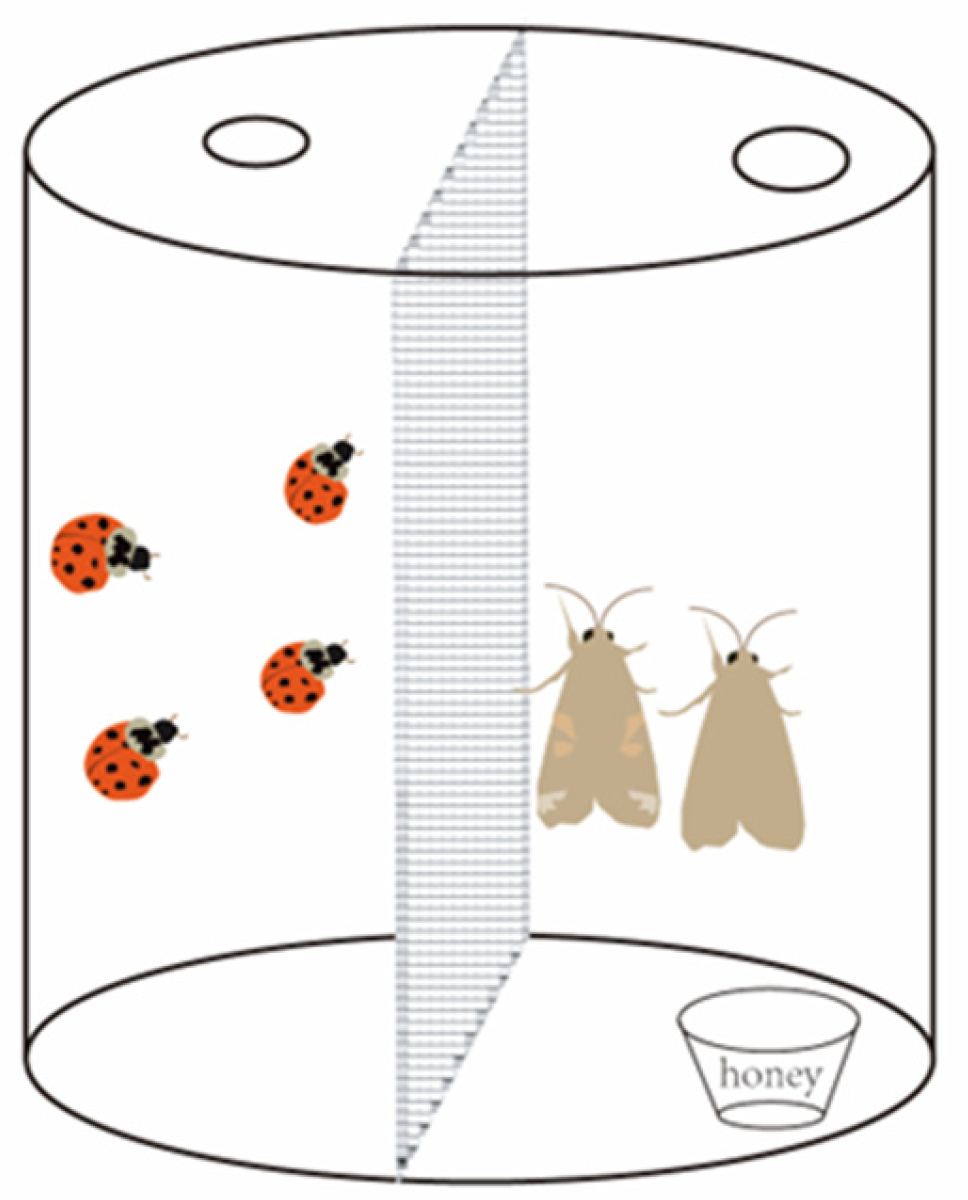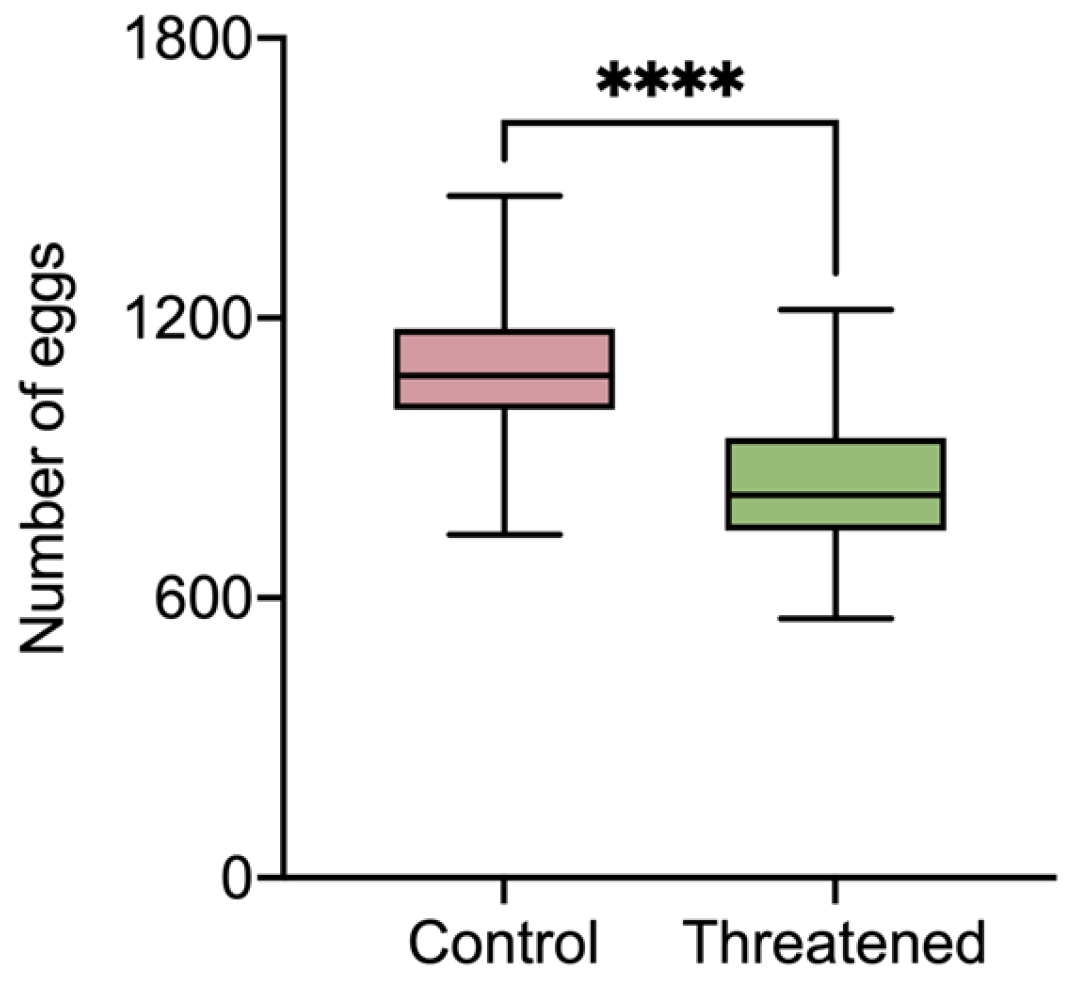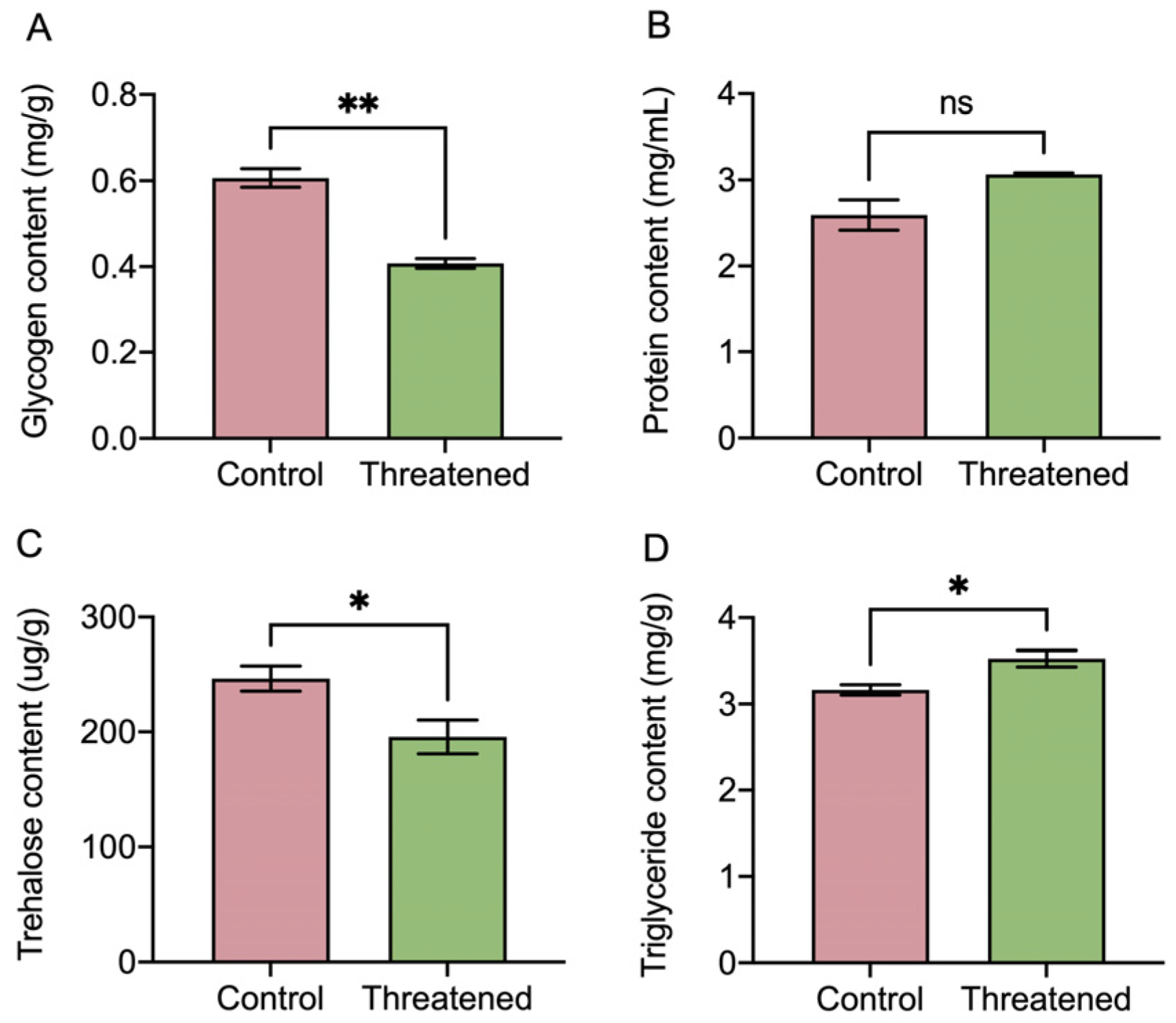Non-Consumptive Effects of Harmonia axyridis on the Reproduction and Metabolism of Spodoptera frugiperda
Abstract
:Simple Summary
Abstract
1. Introduction
2. Materials and Methods
2.1. Plants and Insects
2.2. Experimental Setup
2.3. Non-Consumptive Effects of the H. axyridis on S. frugiperda Reproduction
2.4. Sample Preparation and Physiological Indicator Content Determination
2.5. Data Analysis
3. Results
3.1. Non-Consumptive Effects of Natural Predatory Enemies on the Biology of S. frugiperda
3.2. Non-Consumptive Effects of S. frugiperda Adults on Hormone Activities and VTG Content
4. Discussion
Author Contributions
Funding
Data Availability Statement
Acknowledgments
Conflicts of Interest
References
- Mayhew, P.J. Why are there so many insect species? Perspectives from Fossils and Phylogenies. Biol. Rev. Camb. Philos. Soc. 2007, 82, 425–454. [Google Scholar] [CrossRef] [PubMed]
- Cinel, S.D.; Hahn, D.A.; Kawahara, A.Y. Predator-induced stress responses in insects: A review. J. Insect Physiol. 2020, 122, 104039. [Google Scholar] [CrossRef] [PubMed]
- Gely, C.; Laurance, S.G.W.; Stork, N.E. How do herbivorous insects respond to drought stress in trees? Biol. Rev. Camb. Philos. Soc. 2020, 95, 434–448. [Google Scholar] [CrossRef] [PubMed]
- Sinclair, B.J.; Ferguson, L.V.; Salehipour-shirazi, G.; MacMillan, H.A. Cross-tolerance and cross-talk in the cold: Relating low temperatures to desiccation and immune stress in insects. Integr. Comp. Biol. 2013, 53, 545–556. [Google Scholar] [CrossRef] [PubMed]
- Halsch, C.A.; Shapiro, A.M.; Fordyce, J.A.; Nice, C.C.; Thorne, J.H.; Waetjen, D.P.; Forister, M.L. Insects and recent climate change. Proc. Natl. Acad. Sci. USA 2021, 118, e2002543117. [Google Scholar] [CrossRef] [PubMed]
- Kaitala, A. Wing muscle dimorphism: Two reproductive pathways of the waterstrider Gerris thoracicus in relation to habitat instability. Oikos 1988, 53, 222–228. [Google Scholar] [CrossRef]
- Nummelin, M.; Lodenius, M.; Tulisalo, E.; Hirvonen, H.; Alanko, T. Predatory insects as bioindicators of heavy metal pollution. Environ. Pollut. 2007, 145, 339–347. [Google Scholar] [CrossRef] [PubMed]
- Roels, S.M.; Porter, J.L.; Lindell, C.A. Predation pressure by birds and arthropods on herbivorous insects affected by tropical forest restoration strategy. Restor. Ecol. 2018, 26, 1203–1211. [Google Scholar] [CrossRef]
- Alomar, A.A.; Alto, B.W. Mosquito responses to lethal and nonlethal effects of predation and an insect growth regulator. Ecosphere 2021, 12, e03452. [Google Scholar] [CrossRef]
- Pang, L.; Liu, Z.; Chen, J.; Dong, Z.; Zhou, S.; Zhang, Q.; Huang, J. Search performance and octopamine neuronal signaling mediate parasitoid induced changes in Drosophila oviposition behavior. Nat. Commun. 2022, 13, 4476. [Google Scholar] [CrossRef]
- Elliott, K.H.; Betini, G.S.; Dworkin, I.; Norris, D.R. Experimental evidence for within- and cross-seasonal effects of fear on survival and reproduction. J. Anim. Ecol. 2016, 85, 507–515. [Google Scholar] [CrossRef] [PubMed]
- Sheriff, M.J.; Peacor, S.D.; Hawlena, D.; Thaker, M. Non-consumptive predator effects on prey population size: A dearth of evidence. J. Anim. Ecol. 2020, 89, 1302–1316. [Google Scholar] [CrossRef] [PubMed]
- Sun, J.; Bai, Y. Predator-induced stress influences fall armyworm immune response to inoculating bacteria. J. Invertebr. Pathol. 2020, 172, 107352. [Google Scholar] [CrossRef] [PubMed]
- Hermann, S.L.; Landis, D.A. Scaling up our understanding of non-consumptive effects in insect systems. Curr. Opin. Insect Sci. 2017, 20, 54–60. [Google Scholar] [CrossRef] [PubMed]
- Jandricic, S.E.; Schmidt, D.; Bryant, G.; Frank, S.D. Non-consumptive predator effects on a primary greenhouse pest: Predatory mite harassment reduces western flower thrips abundance and plant damage. Biol. Control 2016, 95, 5–12. [Google Scholar] [CrossRef]
- Thaler, J.S.; Griffin, C.A.M. Relative importance of consumptive and non-consumptive effects of predators on prey and plant damage: The influence of herbivore ontogeny. Entomol. Exp. Appl. 2008, 128, 34–40. [Google Scholar] [CrossRef]
- Dupuy, M.M.; Ramirez, R.A. Consumptive and non-consumptive effects of predatory arthropods on billbug (Coleoptera: Dryophthoridae) pests in turfgrass. Biol. Control 2019, 129, 136–147. [Google Scholar] [CrossRef]
- Norris, R.H.; Silva-Torres, C.S.A.; Lujan, M.; Wilson-Rankin, E.E.; Mauck, K.E. Footprints of predatory lady beetles stimulate increased dispersal of aphid prey, but do not alter feeding behavior or spread of a non-persistently transmitted plant virus. Food Webs. 2023, 37, e00325. [Google Scholar] [CrossRef]
- Preisser, E.L.; Bolnick, D.I. The many faces of fear: Comparing the pathways and impacts of nonconsumptive predator effects on prey populations. PLoS ONE 2008, 3, e2465. [Google Scholar] [CrossRef]
- Seo, M.; Rivera, M.J.; Stelinski, L.L. Trail chemicals of the convergens ladybird beetle, Hippodamia Convergens, Reduce feeding and oviposition by Diaphorina citri (Hemiptera: Psyllidae) on citrus plants. J. Insect Behav. 2018, 31, 298–308. [Google Scholar] [CrossRef]
- Janssens, L.; Stoks, R. Predation risk causes oxidative damage in prey. Biol. Lett. 2013, 9, 20130350. [Google Scholar] [CrossRef] [PubMed]
- Fischer, S.; Pereyra, D.; Fernández, L. Predation ability and non-consumptive effects of Notonecta sellata (Heteroptera: Notonectidae) on immature stages of Culex pipiens (Diptera: Culicidae). J. Vector Ecol. 2012, 37, 245–251. [Google Scholar] [CrossRef]
- Ashley, T.R.; Wiseman, B.R.; Davis, F.M.; Andrews, K.L. The fall armyworm: A bibliography. Fla. Entomol. 1989, 72, 152–202. [Google Scholar]
- Li, C.; Liao, J.; Ya, Y.; Liu, J.; Li, J.; Yu, G. Analysis of potential distribution of Spodoptera frugiperda in western China. J. Asia-Pac. Entomol. 2022, 25, 101985. [Google Scholar] [CrossRef]
- Koch, R.L. The multicolored asian lady beetle, Harmonia axyridis: A review of its biology, uses in biological control, and non-target impacts. J. Insect Sci. 2003, 3, 32. [Google Scholar] [CrossRef] [PubMed]
- Di, N.; Zhang, K.; Xu, Q.; Zhang, F.; Harwood, J.D.; Wang, S.; Desneux, N. Predatory ability of Harmonia axyridis (Coleoptera: Coccinellidae) and Orius sauteri (Hemiptera: Anthocoridae) for suppression of fall armyworm Spodoptera frugiperda (Lepidoptera: Noctuidae). Insects 2021, 12, 1063. [Google Scholar] [CrossRef] [PubMed]
- Lin, K.; Li, Y.; Wang, M.; Liu, C.; Mao, J.; Che, H.; Zhang, L. Predation of Hippodamia variegata and Harmonia axyridis to young larvae of Spodoptera frugiperda. Insect Biochem. Mol. Biol. 2019, 35, 709. [Google Scholar] [CrossRef]
- Zhan, Y.; Wang, J.; Kong, X.; Liu, Y. Perception and kairomonal response of the coccinellid predator (Harmonia Axyridis) to the fall armyworm (Spodoptera Frugiperda) sex pheromone. Front. Physiol. 2023, 14, 1167174. [Google Scholar] [CrossRef] [PubMed]
- Hermann, S.L.; Thaler, J.S. Prey Perception of predation risk: Volatile chemical cues mediate non-consumptive effects of a predator on a herbivorous insect. Oecologia 2014, 176, 669–676. [Google Scholar] [CrossRef]
- McCauley, S.J.; Rowe, L.; Fortin, M.J. The deadly effects of “nonlethal” predators. Ecology 2011, 92, 2043–2048. [Google Scholar] [CrossRef]
- Zanette, L.Y.; White, A.F.; Allen, M.C.; Clinchy, M. Perceived predation risk reduces the number of offspring songbirds produce per year. Science 2011, 334, 1398–1401. [Google Scholar] [CrossRef] [PubMed]
- Wen, J.; Ueno, T. Application of predator-associated cues to control small brown planthoppers: Non-consumptive effects of predators suppress the pest population. BioControl 2021, 66, 813–824. [Google Scholar] [CrossRef]
- Song, J.; Zhou, S. Post-transcriptional regulation of insect metamorphosis and oogenesis. Cell. Mol. Life Sci. 2020, 77, 1893–1909. [Google Scholar] [CrossRef] [PubMed]
- Chang, Y.W.; Wang, Y.C.; Yan, Y.Q.; Wu, C.D.; Xie, H.F.; Gong, W.R.; Du, Y.Z. Insect hormones affect the toxicity of the insecticidal growth regulator cyromazine in Liriomyza trifolii (Diptera: Agromyzidae). Pestic. Biochem. Physiol. 2022, 188, 105263. [Google Scholar] [CrossRef] [PubMed]
- Sang, W.; Yu, L.; He, L.; Ma, W.H.; Zhu, Z.H.; Zhu, F.; Wang, X.P.; Lei, C.L. Uvb radiation delays Tribolium castaneum metamorphosis by influencing ecdysteroid metabolism. PLoS ONE 2016, 11, e0151831. [Google Scholar] [CrossRef] [PubMed]
- Yang, M.; Li, G.; Yu, L.; Du, S.; Jiang, D.; Chu, X.; Wang, K.; Wu, S.; Wang, R.; Zhang, F.; et al. Temperature and metal ions regulate larval diapause termination via the 20-hydroxyecdysone and juvenile hormone pathways in Monochamus alternatus. Pest. Manag. Sci. 2023, 79, 437–446. [Google Scholar] [CrossRef] [PubMed]
- Zhou, X.; Coll, M.; Applebaum, S.W. Effect of temperature and photoperiod on juvenile hormone biosynthesis and sexual maturation in the cotton bollworm, Helicoverpa armigera: Implications for life history traits. Insect Biochem. Mol. Biol. 2000, 30, 863–868. [Google Scholar] [CrossRef] [PubMed]
- Mu, Y.; Hu, X.; Yang, P.; Sun, L.; Gu, W.; Zhang, M. The effects of cadmium on the development of Drosophila and its transgenerational inheritance effects. Toxicology 2021, 462, 152931. [Google Scholar] [CrossRef] [PubMed]
- Zhang, W.; Liu, Y.; Wang, Z.; Lin, T.; Feng, J.; Jiang, T. Effects of predation risks of bats on the growth, development, reproduction, and hormone levels of Spodoptera litura. Front. Ecol. Evol. 2023, 11, 1126253. [Google Scholar] [CrossRef]
- Li, H.; Zhang, S. Functions of vitellogenin in eggs. Results Probl. Cell Differ. 2017, 63, 389–401. [Google Scholar] [CrossRef]
- Zhai, Q.H.; Zhang, J.Z.; Gong, H. Regulation of vitellogenin synthesis by juvenile hormone analogue in Coccinella septempunctata. Insect Biochem. Mol. Biol. 1987, 17, 1059–1064. [Google Scholar] [CrossRef]
- Qi, H.; Cao, H.; Zhao, Y.; Cao, Y.; Jin, Q.; Wang, Y.; Zhang, K.; Deng, D. Cloning and functional analysis of the molting gene Cyp302a1 of Daphnia sinensis. Front. Zool. 2023, 20, 2. [Google Scholar] [CrossRef] [PubMed]
- Herb, M.; Schramm, M. Functions of ros in macrophages and antimicrobial immunity. Antioxidants 2021, 10, 313. [Google Scholar] [CrossRef]
- Woolley, J.F.; Stanicka, J.; Cotter, T.G. Recent advances in reactive oxygen species measurement in biological systems. Trends Biochem. Sci. 2013, 38, 556–565. [Google Scholar] [CrossRef]
- Orčić, S.; Nikolić, T.; Purać, J.; Šikoparija, B.; Blagojević, D.P.; Vukašinović, E.; Plavša, N.; Stevanović, J.; Kojić, D. Seasonal variation in the activity of selected antioxidant enzymes and malondialdehyde level in worker honey bees. Entomol. Exp. Appl. 2017, 165, 120–128. [Google Scholar] [CrossRef]
- Wang, J.; He, Y.; Peng, X.; Bo, L.; Wang, Z.; Song, Q. Characterization of cadmium-responsive transcription factors in wolf spider Pardosa pseudoannulata. Chemosphere 2021, 268, 129239. [Google Scholar] [CrossRef] [PubMed]
- Venkanna, Y.; Suroshe, S.S.; Dahuja, A. Non-consumptive effects of the zigzag ladybird beetle, Cheilomenes Sexmaculata (Fab.) on its prey, the cotton aphid, Aphis Gossypii Glover. Biocontrol Sci. Technol. 2021, 31, 1204–1219. [Google Scholar] [CrossRef]
- Schmitz, O.J.; Rosenblatt, A.E. The temperature dependence of predation stress and prey nutritional stoichiometry. Front. Ecol. Evol. 2017, 5, 73. [Google Scholar] [CrossRef]
- Wat, L.W.; Chao, C.; Bartlett, R.; Buchanan, J.L.; Millington, J.W.; Chih, H.J.; Chowdhury, Z.S.; Biswas, P.; Huang, V.; Shin, L.J.; et al. A role for triglyceride lipase brummer in the regulation of sex differences in Drosophila fat storage and breakdown. PLoS Biol. 2020, 18, e3000595. [Google Scholar] [CrossRef]
- Canavoso, L.E.; Jouni, Z.E.; Karnas, K.J.; Pennington, J.E.; Wells, M.A. Fat metabolism in insects. Annu. Rev. Nutr. 2001, 21, 23–46. [Google Scholar] [CrossRef]
- Skowronek, P.; Wójcik, Ł.; Strachecka, A. Fat body-multifunctional insect tissue. Insects 2021, 12, 547. [Google Scholar] [CrossRef] [PubMed]
- Arrese, E.L.; Soulages, J.L. Insect fat body: Energy, metabolism, and regulation. Annu. Rev. Entomol. 2010, 55, 207–225. [Google Scholar] [CrossRef] [PubMed]
- Bretscher, H.; O’Connor, M.B. The Role of muscle in insect energy homeostasis. Front. Physiol. 2020, 11, 580687. [Google Scholar] [CrossRef] [PubMed]
- Kaplan, I.; McArt, S.H.; Thaler, J.S. Plant defenses and predation risk differentially shape patterns of consumption, growth, and digestive efficiency in a guild of leaf-chewing insects. PLoS ONE 2014, 9, e93714. [Google Scholar] [CrossRef] [PubMed]
- Hawlena, D.; Schmitz, O.J. Physiological stress as a fundamental mechanism linking predation to ecosystem functioning. Am. Nat. 2010, 176, 537–556. [Google Scholar] [CrossRef] [PubMed]
- Redinger, J.M.; Halvorson, H.M.; Gifford, M.E. Variable stoichiometric and macronutrient responses to lizard predation in Ozark glade grasshopper communities. Oecologia 2022, 199, 757–768. [Google Scholar] [CrossRef] [PubMed]
- Zhang, C.; Jansen, M.; De Meester, L.; Stoks, R. Energy storage and fecundity explain deviations from ecological stoichiometry predictions under global warming and size-selective predation. J. Anim. Ecol. 2016, 85, 1431–1441. [Google Scholar] [CrossRef] [PubMed]
- Gish, M. Aphids detect approaching predators using plant-borne vibrations and visual cues. J. Pest Sci. 2021, 94, 1209–1219. [Google Scholar] [CrossRef]
- Zha, Y.P.; Lei, C.L. Effects of ultrasound-stress on antioxidant enzyme activities of Helicoverpa armigera (Hübner) (Lepidoptera: Noctuidae). J. Agr. Urban Entomol. 2012, 28, 34–41. [Google Scholar] [CrossRef]
- Frank, D.A. Evidence for top predator control of a grazing ecosystem. Oikos 2008, 117, 1718–1724. [Google Scholar] [CrossRef]
- Schwenke, R.A.; Lazzaro, B.P.; Wolfner, M.F. Reproduction-immunity trade-offs in Insects. Annu. Rev. Entomol. 2016, 61, 239–256. [Google Scholar] [CrossRef]
- Wright, C.M.; Lichtenstein, J.L.L.; Montgomery, G.A.; Luscuskie, L.P.; Pinter-Wollman, N.; Pruitt, J.N. Exposure to predators reduces collective foraging aggressiveness and eliminates its relationship with colony personality composition. Behav. Ecol. Sociobiol. 2017, 71, 126. [Google Scholar] [PubMed]
- Culshaw-Maurer, M.; Sih, A.; Rosenheim, J.A. Bugs scaring bugs: Enemy-risk effects in biological control systems. Ecol. Lett. 2020, 23, 1693–1714. [Google Scholar] [CrossRef] [PubMed]
- Buchanan, A.L.; Hermann, S.L.; Lund, M.; Szendrei, Z. A meta-analysis of non-consumptive predator effects in arthropods: The Influence of organismal and environmental characteristics. Oikos 2017, 126, 1233–1240. [Google Scholar] [CrossRef]
- Schmitz, O.J.; Grabowski, J.H.; Peckarsky, B.L.; Preisser, E.L.; Trussell, G.C.; Vonesh, J.R. From individuals to ecosystem function: Toward an integration of evolutionary and ecosystem ecology. Ecology 2008, 89, 2436–2445. [Google Scholar] [CrossRef] [PubMed]
- Sih, A.; Bolnick, D.I.; Luttbeg, B.; Orrock, J.L.; Peacor, S.D.; Pintor, L.M.; Preisser, E.; Rehage, J.S.; Vonesh, J.R. Predator–prey naïveté, antipredator behavior, and the ecology of predator invasions. Oikos 2010, 119, 610–621. [Google Scholar] [CrossRef]
- Nakano, R.; Ito, A.; Tokumaru, S. Sustainable pest control inspired by prey-predator ultrasound interactions. Proc. Natl. Acad. Sci. USA 2022, 119, e2211007119. [Google Scholar] [CrossRef]
- Rypstra, A.L.; Buddle, C.M. Spider silk reduces insect herbivory. Biol. Lett. 2013, 9, 20120948. [Google Scholar] [CrossRef]





Disclaimer/Publisher’s Note: The statements, opinions and data contained in all publications are solely those of the individual author(s) and contributor(s) and not of MDPI and/or the editor(s). MDPI and/or the editor(s) disclaim responsibility for any injury to people or property resulting from any ideas, methods, instructions or products referred to in the content. |
© 2024 by the authors. Licensee MDPI, Basel, Switzerland. This article is an open access article distributed under the terms and conditions of the Creative Commons Attribution (CC BY) license (https://creativecommons.org/licenses/by/4.0/).
Share and Cite
Fan, Z.; Lv, X.; Huang, Y.; Kong, W.; Ma, C.; Yan, H. Non-Consumptive Effects of Harmonia axyridis on the Reproduction and Metabolism of Spodoptera frugiperda. Insects 2024, 15, 395. https://doi.org/10.3390/insects15060395
Fan Z, Lv X, Huang Y, Kong W, Ma C, Yan H. Non-Consumptive Effects of Harmonia axyridis on the Reproduction and Metabolism of Spodoptera frugiperda. Insects. 2024; 15(6):395. https://doi.org/10.3390/insects15060395
Chicago/Turabian StyleFan, Zeyun, Xiaolu Lv, Yuyang Huang, Weizhen Kong, Chongjian Ma, and He Yan. 2024. "Non-Consumptive Effects of Harmonia axyridis on the Reproduction and Metabolism of Spodoptera frugiperda" Insects 15, no. 6: 395. https://doi.org/10.3390/insects15060395




